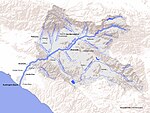KTIE
KTIE (590 AM, "AM 590 The Answer") is a commercial radio station licensed to San Bernardino, California. It is owned by the Salem Media Group, with studios on University Avenue in Riverside, California, and it airs a conservative talk radio format. The station serves the Inland Empire of California, including San Bernardino, Riverside, Redlands and Lake Arrowhead. By day, KTIE broadcasts at 2,500 watts, but to avoid interference with other stations on 590 AM at night, it reduces power to 960 watts. KTIE has a directional signal, heard in San Bernardino County, Riverside County and parts of Orange County. KTIE transmits using a three-tower array, on Auto Center Drive West in San Bernardino.
Excerpt from the Wikipedia article KTIE (License: CC BY-SA 3.0, Authors).KTIE
Show Case Drive South, San Bernardino
Geographical coordinates (GPS) Address Nearby Places Show on map
Geographical coordinates (GPS)
| Latitude | Longitude |
|---|---|
| N 34.072222222222 ° | E -117.29777777778 ° |
Address
Show Case Drive South 1076
92408 San Bernardino
California, United States
Open on Google Maps





